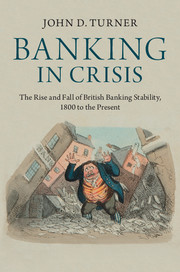Book contents
- Frontmatter
- Contents
- List of figures
- List of tables
- Acknowledgements
- 1 Introduction: Holding shareholders to account
- 2 Banking instability and risk shifting
- 3 The evolution of British banking structure and stability since 1800
- 4 Major and minor British banking crises since 1800
- 5 Banking stability, shareholder liability and bank capital
- 6 Averting or creating banking crises? The lender of last resort and bank rescues
- 7 Banking stability and bank regulation
- 8 Restoring banking stability: Policy and political economy
- Bibliography
- Index
5 - Banking stability, shareholder liability and bank capital
Published online by Cambridge University Press: 05 July 2014
- Frontmatter
- Contents
- List of figures
- List of tables
- Acknowledgements
- 1 Introduction: Holding shareholders to account
- 2 Banking instability and risk shifting
- 3 The evolution of British banking structure and stability since 1800
- 4 Major and minor British banking crises since 1800
- 5 Banking stability, shareholder liability and bank capital
- 6 Averting or creating banking crises? The lender of last resort and bank rescues
- 7 Banking stability and bank regulation
- 8 Restoring banking stability: Policy and political economy
- Bibliography
- Index
Summary
A substantial banquier is to bee hanged hear today for making bankerupt; I know not whether that bee ye best way of preventing others from ye like practices….
Henry Savile (Envoy at Paris) in a letter from Paris, 31 January 1682Introduction
Chapters 3 and 4 discuss the two major or systemic banking crises that the UK banking system has had since 1800. The first major crisis occurred in 1825–6, when almost one fifth of the English banking system collapsed; the second major crisis was the Great Crash of 2007–8. In the period between these two crises, there were episodes of stress in the banking system and occasionally banks failed, but the banking system proved robust to the shocks that it experienced. Ultimately, we might ask why the British banking system was free of major banking crises between 1826 and 2006 and why it experienced major crises at the beginning and end of this period. This chapter describes how both major crises occurred in an environment of poorly capitalised banking institutions.
The stability of the banking system in the long hiatus between these two major crises was not due to the absence of shocks to the banking system, as discussed in the previous chapter. Rather, as argued in this chapter, the stability of the system appears to be associated with banks having adequate capital until the interwar period and the fact that, after this period, substitutes for adequate capital were available. In particular, it was of central importance to the stability of the British banking system in the period before the 1930s that contingent capital (i.e., capital that could be called up in case of bank failure) was available in the form of unlimited shareholder liability, uncalled capital and reserve liability. The latter two types of contingent capital were similar to the double-liability rules that existed in the United States until the 1930s, except that the liability faced by shareholders was decided on by individual banks rather than imposed by legislation.
- Type
- Chapter
- Information
- Banking in CrisisThe Rise and Fall of British Banking Stability, 1800 to the Present, pp. 102 - 139Publisher: Cambridge University PressPrint publication year: 2014



